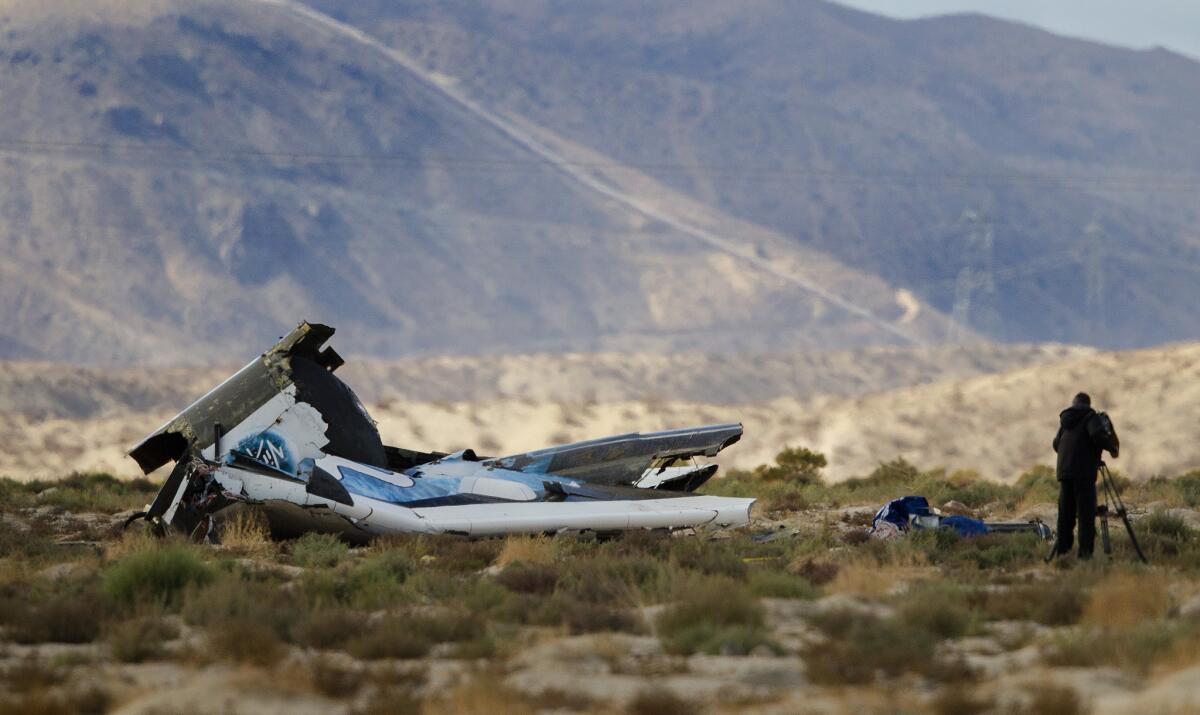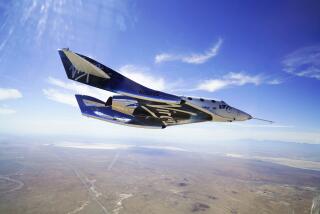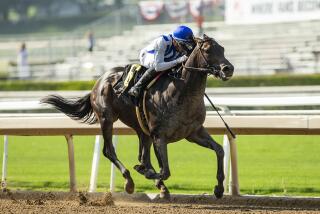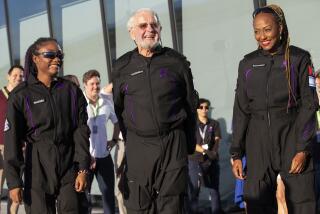How Virgin Galactic’s spaceship pilot survived a 10-mile fall back to Earth

An investigator surveys the scene at the wreckage site of the Virgin Galactic Spaceship Two after it crashed Oct. 31 in the Mojave Desert.
- Share via
The Halloween morning test flight was the first time that Virgin Galactic’s SpaceShipTwo would blast toward the heavens under the power of a new rocket motor.
And in the days before, pilot Peter Siebold had prepared intensely, spending hours in a flight simulator, going through the “what ifs.” He considered the mission to be “high risk.”
But it wasn’t until SpaceShipTwo was more than 10 miles above the Mojave Desert and had passed through the sound barrier that Siebold noticed something was seriously wrong.
Seconds later, Siebold heard a loud bang and then a sound — like “paper fluttering in the wind” — which he now knows was the rocket plane breaking apart. And suddenly he was plummeting to Earth.
Siebold’s story of how he survived the disintegration of SpaceShipTwo and his fall of more than 50,000 feet to Earth was released Tuesday by the National Transportation Safety Board.
The interviews with federal investigators is the first time the public has heard an account from Siebold about the crash — which killed his copilot and was a significant setback for British billionaire Richard Branson’s goal of making money by flying wealthy tourists to space.
Siebold, 44, and copilot Michael Alsbury were longtime employees of Scaled Composites, the famed aerospace firm in Mojave that had designed and built SpaceShipTwo.
Siebold said he did not see Alsbury prematurely moving a lever that unlocked the ship’s movable tail — a mistake that investigators say started the sequence of events that caused it to come apart.
Instead, Siebold first knew something was wrong when the experimental rocket plane went supersonic and shot up with surprising force.
The rocket ship suddenly began bucking violently, Siebold told investigators, and the “G-levels went through the roof.”
The force pushed him down in his seat so hard that there was little he could do. It was hard to even breathe.
“It felt as though the vehicle pitched over on its back,” he said.
He heard that single loud crack and the cabin rapidly depressurized. The last air was sucked from his lungs.
His next memory is of being outside the plane, hearing the high-pitched whistle of the wind. He felt like he was in “a very high slipstream of some kind.” The rocket ship had broken up around him.
He had to work to open his eyes. And when he did, he saw the desert far below.
It felt as if forces were trying to rip off his helmet. The helmet had twisted to the left and his mask was no longer sealed.
He believes he fell in and out of consciousness. It was extremely cold — more than 40 degrees below zero at 30,000 feet and above.
NEWSLETTER: Get the day’s top headlines from Times Editor Davan Maharaj >>
Siebold first told investigators that he believed he was still strapped in his seat as he fell. He later said he wasn’t sure. But he remembers the process he took in unfastening his seat belt.
In his mind, he walked through the steps of a bailout. He felt the buckles, reminding himself how they opened and where the emergency oxygen was.
He knew he had to unbuckle — it was the only way the parachute would work.
He thought he may have needed two hands to unbuckle. Then he may have pushed himself out of the seat.
At that point, there was nothing else around him. The cabin was gone. And he was falling through the clouds. Not tumbling, but in a stable position with his head slightly down.
He went into the free-fall position, spreading his arms and legs.
Somewhere between 10,000 and 20,000 feet, his parachute deployed automatically. He said the sudden jolt surprised him, as if waking him from sleep.
No longer free-falling, his mind began allowing him to absorb more information. Events began to slow down.
He began searching the sky for Alsbury, looking for another chute, hoping his copilot was above him.
The mission’s chase plane spotted him and began circling. He believes he waved at the pilot.
Repeatedly, he tried to get the emergency oxygen to flow, but the mask didn’t work.
He realized his right shoulder was badly hurt. He thought it was dislocated and he tried to push it back. He wanted to be able to steer the chute.
As Siebold dropped below 5,000 feet, he noticed he was coming down fast. He braced for a hard landing.
But the winds were calm. He touched down and fell forward into a creosote bush.
Then he waited for what seemed like “a really long time for the responders.”
His eyes were painful and watery. The right eye wouldn’t open. He guessed they may have gotten ice crystals in them from the extreme cold in the sky’s upper reaches.
He tried to take his parachute harness off but heard a “clunking noise” in his chest. He decided not to move again before rescuers arrived.
He knew his right arm was badly hurt. His chest was covered with blood.
The first helicopter on scene was from the National Test Pilot School in Mojave. The crew tried to use his parachute to stabilize him until a second helicopter with a medical team arrived.
Authorities found the body of his copilot, Alsbury, the father of two young children, in the wreckage nearby.
At the hospital, Siebold learned his right upper arm was broken in four places. His collarbone was also fractured. He had a small gash in his right elbow, the source of the blood in his flight suit. He had multiple other cuts, scrapes and bruises.
Doctors told him that he had only corneal scratches in his eyes. But while still in the hospital, he removed a piece of fiberglass from his left eye.
Just three days after the accident, Siebold went home to Tehachapi, where he lives with his wife and two children.
His sight didn’t improve until an ophthalmologist removed more foreign matter from his left eyelid, as well as a “silver sliver” from his right cornea.
At the end of the interview, investigators asked Siebold whether he had anything more to say. He thanked them and said he felt fortunate to have survived.
Follow me on Twitter @MelodyPetersen.
MORE ON VIRGIN GALACTIC:
Virgin Galactic fatal crash sends tremors through commercial space industry
Virgin Galactic ticket holder still eager to go to space despite crash
Graphic: How Virgin Galactic’s spaceship is supposed to work
More to Read
Inside the business of entertainment
The Wide Shot brings you news, analysis and insights on everything from streaming wars to production — and what it all means for the future.
You may occasionally receive promotional content from the Los Angeles Times.










